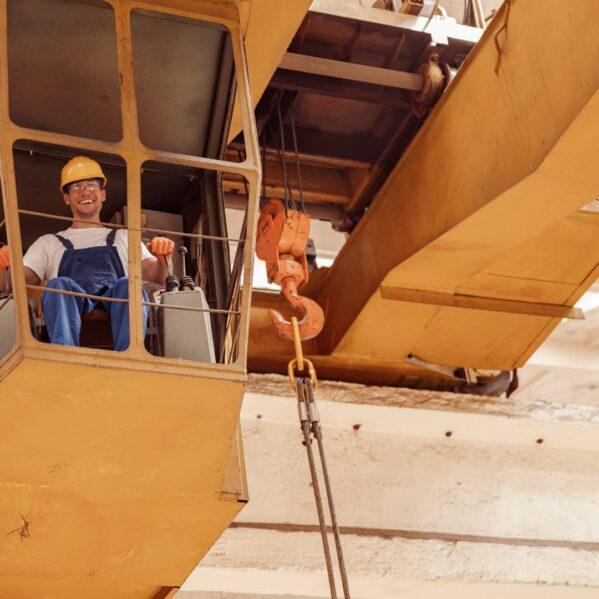Anti-collision devices for overhead cranes are essential safety measures to prevent collisions between cranes, loads, and other objects in the working area. These devices help minimize accidents, protect personnel, and avoid damage to equipment and structures. Anti-collision devices for overhead cranes are essential for preventing accidents and collisions between cranes, loads, and structures within a crane’s working area. These devices help enhance safety and protect both personnel and equipment. Here are some common types of anti-collision devices for overhead cranes:
1. Laser Anti-Collision Systems:
- Laser Scanners: These devices use laser beams to detect obstacles or other cranes in the crane’s path. When an obstruction is detected, the system can trigger an alarm, slow down or stop the crane’s motion, or initiate an emergency stop.
- Laser Distance Sensors: These sensors measure the distance to objects in the crane’s vicinity and provide real-time data to the crane’s control system, allowing it to adjust its path or speed to avoid collisions.
2. Radio Frequency Identification (RFID) Systems:
- RFID tags can be attached to crane loads, structures, or other equipment. The crane’s RFID reader can detect these tags and determine their positions, helping the crane operator avoid collisions.
- Radio Frequency Identification (RFID) is a technology that uses radio waves to identify and track objects or individuals. It consists of three main components: RFID tags, RFID readers, and a computer system.
3. Ultrasonic Sensors:
- Ultrasonic sensors use sound waves to detect obstacles. When an object is too close to the crane, the sensors send signals to the control system to take preventive actions.
4. Infrared Sensors:
- Infrared sensors can detect heat sources and are often used to identify the presence of objects or personnel in the crane’s path. If a person or object is detected, the crane can be programmed to stop or slow down.
- Ultrasonic sensors are commonly used as anti-collision devices for overhead cranes to enhance safety and prevent collisions with objects, obstacles, or personnel within the crane’s working area.
- These sensors use sound waves with frequencies beyond the range of human hearing to detect the distance between the sensor and the objects in its vicinity.
5. Wireless Crane-to-Crane Communication:
- This system enables communication between multiple cranes operating in the same area. Cranes share information about their positions and movements, allowing them to coordinate and avoid collisions.
- cranes operating in the same area to exchange information, coordinate movements, and enhance safety. This communication system is particularly useful in industrial environments where multiple cranes are working in close proximity to each other.
6. Cameras and Visual Systems:
- Cameras mounted on the crane provide the operator with a visual feed of the crane’s surroundings. This helps the operator navigate and avoid obstacles or other cranes.
- 360-degree camera systems offer a comprehensive view of the crane’s surroundings, reducing blind spots.
- Cameras and visual systems are essential components of anti-collision devices for overhead cranes. They provide crane operators with real-time visual information about their surroundings, helping to prevent collisions with obstacles, equipment, and personnel.
7. Control System Integration:
- Many modern overhead crane systems have integrated anti-collision features within their control systems. These systems use data from various sensors and devices to monitor the crane’s environment and trigger safety responses when necessary.
- Control system integration is a crucial aspect of anti-collision devices for overhead cranes. It involves incorporating various sensors, communication technologies, and safety protocols into the crane’s control system to prevent collisions and enhance safety.
8. Audible and Visual Alarms:
- These alarms provide immediate warnings to crane operators when potential collisions are detected. Audible alarms may include sirens or beeping sounds, while visual alarms can include flashing lights.
- Audible and visual alarms are important components of anti-collision devices for overhead cranes. They serve as crucial warning mechanisms to alert crane operators and nearby personnel to potential collision hazards or unsafe conditions.
9. Automated Collision Avoidance Software:
- Advanced software solutions can predict potential collisions and automatically adjust crane movements to avoid them. These systems use real-time data from various sensors and devices.
- Automated collision avoidance software is a sophisticated anti-collision device for overhead cranes that utilizes advanced algorithms and technology to prevent collisions and enhance safety.
- This software is typically integrated into the crane’s control system and continuously monitors the crane’s surroundings to detect potential collision hazards.
Conclusion
The choice of anti-collision device depends on factors like the specific crane application, the complexity of the working environment, and budget considerations. Combining multiple anti-collision technologies can provide layered protection and improve overall safety in overhead crane operations. Regular maintenance and testing of these devices are essential to ensure their effectiveness in preventing accidents.



